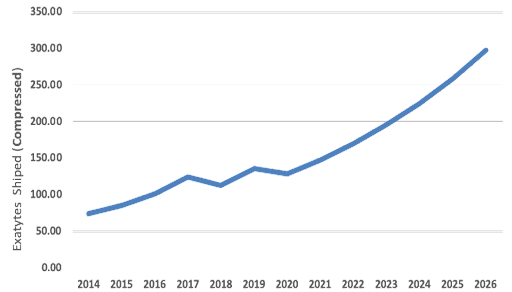After weathering constant attacks about the imminent demise of tape during the first decade of the millennium, tape usage has rebounded. Studies by data storage consulting firm Coughlin Associates show tape capacity shipment almost doubled between 2014 and 2019. In 2019, about 140 exabytes (EB) of compressed tape capacity were shipped. That’s an impressive amount for a supposedly dying medium.

But surprise, surprise: a significant part of the upsurge is the growing use of tape by hyper-scalers like Google, Amazon, and Microsoft. They use tape for their lower-tier, high-capacity offerings. Similarly, large enterprises—and those with the need to store or archive hundreds of terabytes of data (typically 200 TB or more)—favor tape.
The benefits of LTO-9 tape
“Magnetic tape is increasingly recognized as the best storage media for long-term archival of high-volume data, safely and at low-cost,” said Rich Gadomski, tape evangelist at FujiFilm Recording Media USA. “In addition, tape has a significantly lower environmental impact as there is no need to have it constantly powered-on during data storage, thereby reducing CO2 emissions generated during its lifecycle by 95% compared to hard disk drives (HDDs).”
Tom Coughlin, president of Coughlin Associates, predicts that tape usage will soar over the next few years on the back of the recent release of the LTO-9 tape format. LTO-9 offers up to 45 TB of storage capacity (18 TB for non-compressed data), a 50 percent increase from the previous generation of LTO-8. Further, it provides a rise in data transfer rates reaching up to 1,000 MB/sec for compressed data (400 MB/sec native), a 25 percent increase over LTO-8.
Also read: Tape Remains a Critical Part of Enterprise Storage
The future of tape storage
After a slightly down year in 2020 largely attributed to business lockdowns, 2021 is set to show a rebound in tape shipments – reaching close to 150 EB, according to Coughlin Associates. The forecast is for tape usage to double again over the following five years, reaching 300 EB by 2026. That’s an annual projected growth rate of 15 percent over that period.
Clearly, tape isn’t going anywhere. And it is enjoying remarkable vendor support. LTO-9 tape drives, autoloaders, and systems are already available from the likes of IBM, Quantum, Hewlett Packard Enterprise (HPE), and Spectra Logic. IBM has released several LTO-9 ready tape systems. They are designed for the heavy demands of backup and archive tape storage with a view to helping improve data center economics. According to IBM, moving to these LTO-9 models will greatly reduce the number of tape drives, cartridges, and associated floor space required while delivering higher capacity and performance.
On the media side, companies such as FujiFilm, Sony, and IBM have launched LTO-9 tape cartridges. FujiFilm’s LTO Ultrium 9 Data Cartridge uses Barium Ferrite (BaFe) magnetic particles, formulated into fine particles with Nanocubic technology. These particles are evenly distributed to coat tape surfaces, forming a smooth and thin magnetic layer.
But LTO-9 is far from the end of the line on tape R&D. The current roadmap extends through LTO-12, which is expected to offer 144 TB of capacity on one cartridge (up to 360 TB compressed). With a new generation scheduled every 2.5 years, LTO-12 should be with us within 10 years or so.
Read next: How Tape Backup Can Prevent Ransomware


